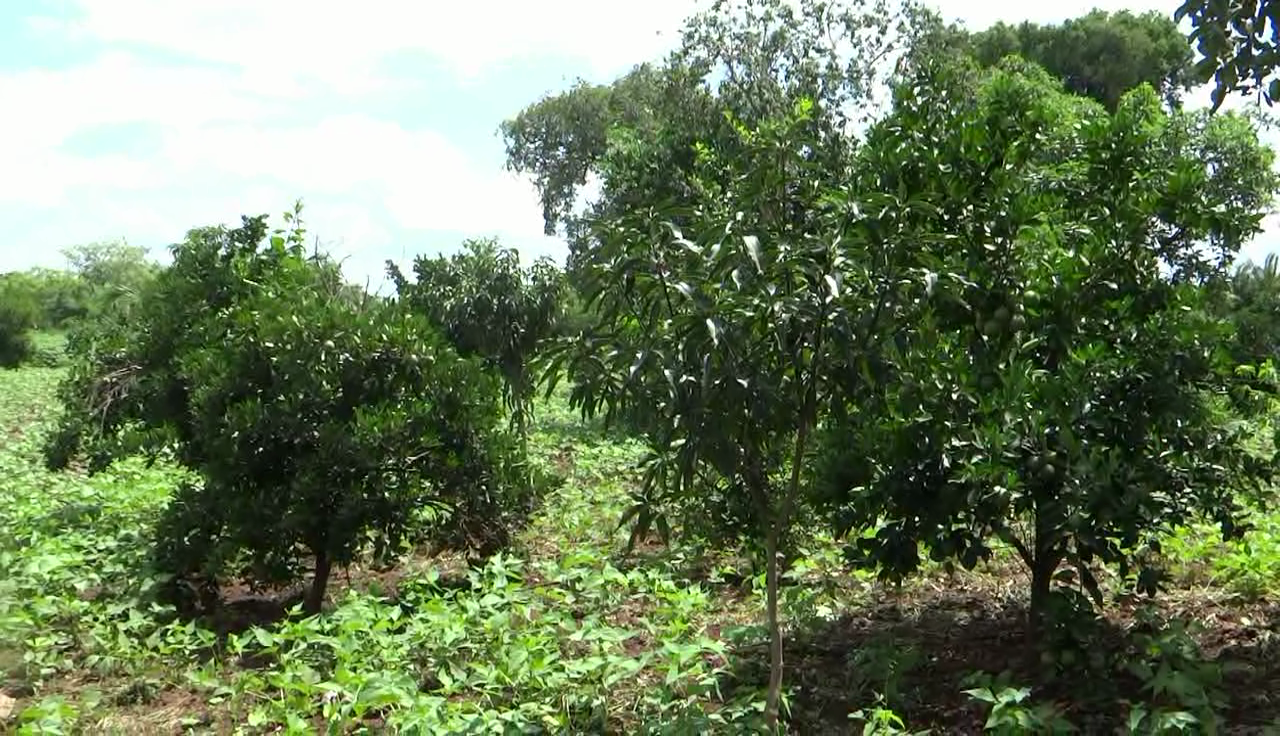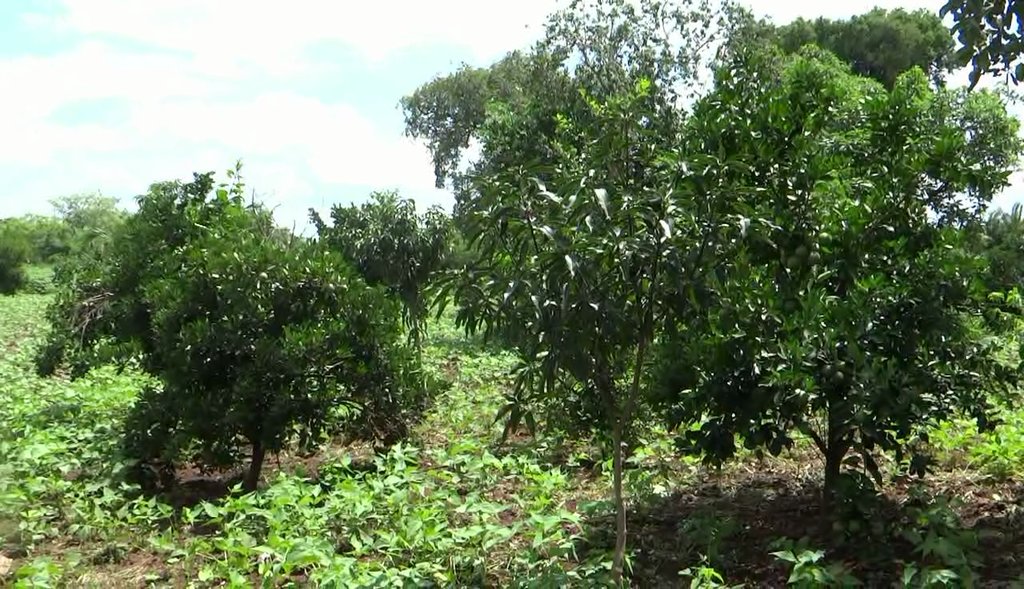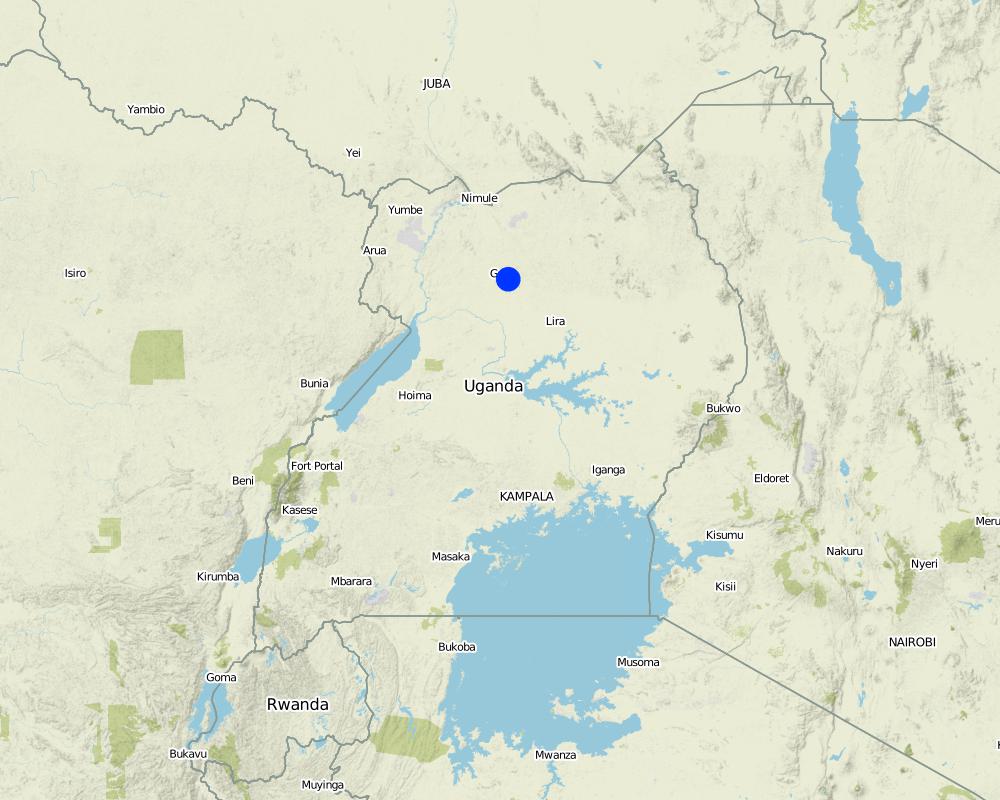Fruit Tree Orchard of Mangoes and Oranges Integrated with Beans [Uganda]
- Creation:
- Update:
- Compiler: Kamugisha Rick Nelson
- Editors: JOY TUKAHIRWA, Richard Otto Kawawa, Sunday Balla Amale, Bernard Fungo
- Reviewers: Drake Mubiru, Nicole Harari, Renate Fleiner, Donia Mühlematter
Mukungwa ki mayembe, muranga idyare
technologies_2787 - Uganda
View sections
Expand all Collapse all1. General information
1.2 Contact details of resource persons and institutions involved in the assessment and documentation of the Technology
Key resource person(s)
land user:
Tusubira Peterson
Farmer
Uganda
Name of project which facilitated the documentation/ evaluation of the Technology (if relevant)
Scaling-up SLM practices by smallholder farmers (IFAD)Name of the institution(s) which facilitated the documentation/ evaluation of the Technology (if relevant)
CDE Centre for Development and Environment (CDE Centre for Development and Environment) - Switzerland1.3 Conditions regarding the use of data documented through WOCAT
When were the data compiled (in the field)?
25/05/2017
The compiler and key resource person(s) accept the conditions regarding the use of data documented through WOCAT:
Ja
1.4 Declaration on sustainability of the described Technology
Is the Technology described here problematic with regard to land degradation, so that it cannot be declared a sustainable land management technology?
Nee
Comments:
Sustainable - Good at controlling soil erosion and can be replicated else where.
2. Description of the SLM Technology
2.1 Short description of the Technology
Definition of the Technology:
Oranges (Citrus sinensis) and Mangoes (Mangifera indicate) integrated with beans are planted together in the same field to increase production and household income.
2.2 Detailed description of the Technology
Description:
The technology is promoted by small scale farmers in Northern Uganda to address soil degradation including soil erosion, low crop productivity and low-income challenges both on farm and at household level. The farmer identified land with average size of 0.6 acres situated on a gentle sloping area (3-5%), measuring 45m wide x 95 m long planted with mangoes spaced 10m × 10m and oranges spaced 4m x 5m integrated with beans, NABE 14 and K20. The beans were planted using a line spacing of 10cm within a line and 30cm between lines with 2-3 seeds per hole. The selected bean varieties are high yielding and marketable. The following are the labour and input requirements for establishing this technology: a hoe, a tape measure, seedlings, 4 people and a panga.
Integration of beans into an already grown mango and orange field is a good and profitable practice because decomposition of the plant litter increases yields of the beans (nitrogen fixing) and the cost incurred, for example in weeding is less compared to the costs which would be incurred when the three enterprises (oranges, mangoes and beans) are planted separately on the same land.
Generally, benefits from implementing this technology are slightly positive ranging from improved soil fertility due to plant litter, reduced soil erosion with the fruit trees providing shade to the beans. After harvesting the beans, the farmer uses the bean waste/ residues as mulching material for the orchard which subsequently decomposes to provide manure. Also the beans cover reduces the moisture evaporation from the soil, thus keeping the soil moist
However, oranges, mangoes and beans are affected by pests and diseases and in case of this; the farmer is likely to suffer since they are planted in one field. The role of the extension worker is very critical at this stage in providing extension advisory services on how to spray the fruit trees when they get affected.
2.3 Photos of the Technology
2.4 Videos of the Technology
Comments, short description:
Video on showing orchard of mangoes and oranges integrated with beans in Omolo District
Date:
15/12/2017
Location:
Aboli village, Abakri Parish, Kolo Sub-county, Omolo district
Name of videographer:
Issa Aiga
2.5 Country/ region/ locations where the Technology has been applied and which are covered by this assessment
Country:
Uganda
Region/ State/ Province:
Northern Region,Uganda
Further specification of location:
Omolo district
Comments:
Map showing technology site in Northern Uganda.
Map
×2.6 Date of implementation
Indicate year of implementation:
2014
If precise year is not known, indicate approximate date:
- less than 10 years ago (recently)
2.7 Introduction of the Technology
Specify how the Technology was introduced:
- through land users' innovation
- through projects/ external interventions
Comments (type of project, etc.):
Started on his own and later Operation Wealth Creation supported with training on how to space beans.
3. Classification of the SLM Technology
3.1 Main purpose(s) of the Technology
- improve production
- reduce, prevent, restore land degradation
- create beneficial economic impact
3.2 Current land use type(s) where the Technology is applied

Mixed (crops/ grazing/ trees), incl. agroforestry
- Agro-silvopastoralism
Main products/ services:
Croplands.
Oranges and mangoes.
Eucalyptus.
Livestock (cows).
3.3 Further information about land use
Water supply for the land on which the Technology is applied:
- rainfed
Number of growing seasons per year:
- 1
Specify:
May - June
Livestock density (if relevant):
2 cows and 3 goats.
3.4 SLM group to which the Technology belongs
- agroforestry
- integrated crop-livestock management
- improved ground/ vegetation cover
3.5 Spread of the Technology
Specify the spread of the Technology:
- evenly spread over an area
If the Technology is evenly spread over an area, indicate approximate area covered:
- < 0.1 km2 (10 ha)
Comments:
Fruit trees planted together in the same field. The farmer also own cows and goats for manure.
3.6 SLM measures comprising the Technology

agronomic measures
- A1: Vegetation/ soil cover
- A2: Organic matter/ soil fertility
- A5: Seed management, improved varieties

vegetative measures
- V1: Tree and shrub cover

structural measures
- S9: Shelters for plants and animals
3.7 Main types of land degradation addressed by the Technology

soil erosion by water
- Wt: loss of topsoil/ surface erosion
- Wg: gully erosion/ gullying
- Wo: offsite degradation effects

soil erosion by wind
- Et: loss of topsoil

chemical soil deterioration
- Cn: fertility decline and reduced organic matter content (not caused by erosion)

physical soil deterioration
- Pu: loss of bio-productive function due to other activities

biological degradation
- Bc: reduction of vegetation cover
- Bh: loss of habitats
- Bl: loss of soil life
3.8 Prevention, reduction, or restoration of land degradation
Specify the goal of the Technology with regard to land degradation:
- prevent land degradation
- reduce land degradation
4. Technical specifications, implementation activities, inputs, and costs
4.1 Technical drawing of the Technology
4.2 Technical specifications/ explanations of technical drawing
The technology is established on a gentle sloping area of (3-5%) of 0.6 acres measuring 45 m long m x 95 m long planted with mangoes spaced 10 m × 10 m and Oranges spaced 4 m x 5 m integrated with NABE 14 , K 20 bean varieties planted in hole dug up to a depth of 40-60 cm.
4.3 General information regarding the calculation of inputs and costs
Specify how costs and inputs were calculated:
- per Technology area
Indicate size and area unit:
0.6 acres of land
other/ national currency (specify):
UGX
Indicate exchange rate from USD to local currency (if relevant): 1 USD =:
3400.0
Indicate average wage cost of hired labour per day:
5000
4.4 Establishment activities
| Activity | Type of measure | Timing | |
|---|---|---|---|
| 1. | site selection planted with Oragnes and Mangoes | Agronomic | once before establishment |
| 2. | Look for labour and required tools | Other measures | Before establishment |
| 3. | Look for bean seeds | Agronomic | Before establishment |
| 4. | Digging holes | Structural | During establishment |
| 5. | Planting seeds | Agronomic | During establishment |
4.5 Costs and inputs needed for establishment
| Specify input | Unit | Quantity | Costs per Unit | Total costs per input | % of costs borne by land users | |
|---|---|---|---|---|---|---|
| Labour | persons days paid on monthly basis | persons | 4.0 | 150000.0 | 600000.0 | 100.0 |
| Equipment | Hoe | pieces | 4.0 | 10000.0 | 40000.0 | 100.0 |
| Equipment | Tape measure | pieces | 1.0 | 7000.0 | 7000.0 | 100.0 |
| Equipment | Panga | pieces | 2.0 | 7000.0 | 14000.0 | 100.0 |
| Plant material | Bean seeds | kgs | 100.0 | 2000.0 | 200000.0 | 100.0 |
| Fertilizers and biocides | Pestcide | litres | 2.0 | 25000.0 | 50000.0 | 100.0 |
| Other | Training | 1 | 1.0 | 50000.0 | 50000.0 | 40.0 |
| Total costs for establishment of the Technology | 961000.0 | |||||
Comments:
Equipment are bought at the time of establishment. Work load reduces during maintenance. 60% of training (seeds, facilitation, extension agent) covered by Operation Wealth Creation.
4.6 Maintenance/ recurrent activities
| Activity | Type of measure | Timing/ frequency | |
|---|---|---|---|
| 1. | Weeding | Management | Once in a season |
| 2. | Spraying | Agronomic | Once in a season |
| 3. | Harvesting | Management | Once in a season |
4.7 Costs and inputs needed for maintenance/ recurrent activities (per year)
| Specify input | Unit | Quantity | Costs per Unit | Total costs per input | % of costs borne by land users | |
|---|---|---|---|---|---|---|
| Labour | persons days on monthly basis | Persons | 3.0 | 150000.0 | 450000.0 | 100.0 |
| Equipment | Spraying pump | Pieces | 1.0 | 75000.0 | 75000.0 | 100.0 |
| Total costs for maintenance of the Technology | 525000.0 | |||||
Comments:
Labour costs are for weeding, spraying and harvesting.
4.8 Most important factors affecting the costs
Describe the most determinate factors affecting the costs:
Labour takes most of the cost during establishing. The farmer only buys a spraying pump for maintenance.
5. Natural and human environment
5.1 Climate
Annual rainfall
- < 250 mm
- 251-500 mm
- 501-750 mm
- 751-1,000 mm
- 1,001-1,500 mm
- 1,501-2,000 mm
- 2,001-3,000 mm
- 3,001-4,000 mm
- > 4,000 mm
Specify average annual rainfall (if known), in mm:
1500.00
Specifications/ comments on rainfall:
Nov- Dec and March -April.
Agro-climatic zone
- humid
- sub-humid
5.2 Topography
Slopes on average:
- flat (0-2%)
- gentle (3-5%)
- moderate (6-10%)
- rolling (11-15%)
- hilly (16-30%)
- steep (31-60%)
- very steep (>60%)
Landforms:
- plateau/plains
- ridges
- mountain slopes
- hill slopes
- footslopes
- valley floors
Altitudinal zone:
- 0-100 m a.s.l.
- 101-500 m a.s.l.
- 501-1,000 m a.s.l.
- 1,001-1,500 m a.s.l.
- 1,501-2,000 m a.s.l.
- 2,001-2,500 m a.s.l.
- 2,501-3,000 m a.s.l.
- 3,001-4,000 m a.s.l.
- > 4,000 m a.s.l.
Indicate if the Technology is specifically applied in:
- concave situations
5.3 Soils
Soil depth on average:
- very shallow (0-20 cm)
- shallow (21-50 cm)
- moderately deep (51-80 cm)
- deep (81-120 cm)
- very deep (> 120 cm)
Soil texture (topsoil):
- medium (loamy, silty)
Soil texture (> 20 cm below surface):
- medium (loamy, silty)
Topsoil organic matter:
- high (>3%)
- medium (1-3%)
5.4 Water availability and quality
Ground water table:
5-50 m
Availability of surface water:
medium
Water quality (untreated):
good drinking water
Is water salinity a problem?
Nee
Is flooding of the area occurring?
Nee
Comments and further specifications on water quality and quantity:
Soils are dry during Dec -March.
5.5 Biodiversity
Species diversity:
- low
Habitat diversity:
- low
5.6 Characteristics of land users applying the Technology
Sedentary or nomadic:
- Sedentary
Market orientation of production system:
- mixed (subsistence/ commercial
Off-farm income:
- less than 10% of all income
Relative level of wealth:
- average
Individuals or groups:
- individual/ household
Level of mechanization:
- manual work
Gender:
- women
- men
Age of land users:
- youth
- middle-aged
Indicate other relevant characteristics of the land users:
He is a business man dealing in a small merchandize items (salt, soap, beans).
5.7 Average area of land owned or leased by land users applying the Technology
- < 0.5 ha
- 0.5-1 ha
- 1-2 ha
- 2-5 ha
- 5-15 ha
- 15-50 ha
- 50-100 ha
- 100-500 ha
- 500-1,000 ha
- 1,000-10,000 ha
- > 10,000 ha
Is this considered small-, medium- or large-scale (referring to local context)?
- small-scale
5.8 Land ownership, land use rights, and water use rights
Land ownership:
- individual, not titled
Land use rights:
- individual
Water use rights:
- communal (organized)
5.9 Access to services and infrastructure
health:
- poor
- moderate
- good
education:
- poor
- moderate
- good
technical assistance:
- poor
- moderate
- good
employment (e.g. off-farm):
- poor
- moderate
- good
markets:
- poor
- moderate
- good
energy:
- poor
- moderate
- good
roads and transport:
- poor
- moderate
- good
drinking water and sanitation:
- poor
- moderate
- good
financial services:
- poor
- moderate
- good
6. Impacts and concluding statements
6.1 On-site impacts the Technology has shown
Socio-economic impacts
Production
production area
Comments/ specify:
Increased due to use of the intercropping space.
land management
Comments/ specify:
Due to litter.
Income and costs
diversity of income sources
Comments/ specify:
Fruits (oranges and mangoes) and beans.
workload
Comments/ specify:
Weeding and harvesting.
Socio-cultural impacts
SLM/ land degradation knowledge
Comments/ specify:
Spacing.
Ecological impacts
Soil
soil cover
Comments/ specify:
Due to litter and mulching using bean residues.
soil loss
soil organic matter/ below ground C
Comments/ specify:
Due to litter and mulching using bean residues.
Biodiversity: vegetation, animals
Vegetation cover
Comments/ specify:
Mulching using bean residues.
6.2 Off-site impacts the Technology has shown
water availability
Comments/ specify:
Exposure to rainfall.
6.3 Exposure and sensitivity of the Technology to gradual climate change and climate-related extremes/ disasters (as perceived by land users)
Gradual climate change
Gradual climate change
| Season | Type of climatic change/ extreme | How does the Technology cope with it? | |
|---|---|---|---|
| annual rainfall | increase | well | |
| seasonal rainfall | wet/ rainy season | increase | moderately |
Climate-related extremes (disasters)
Biological disasters
| How does the Technology cope with it? | |
|---|---|
| epidemic diseases | moderately |
6.4 Cost-benefit analysis
How do the benefits compare with the establishment costs (from land users’ perspective)?
Short-term returns:
slightly positive
Long-term returns:
positive
How do the benefits compare with the maintenance/ recurrent costs (from land users' perspective)?
Short-term returns:
slightly positive
Long-term returns:
positive
Comments:
High costs for paying for labour and buying seed during establishment.
6.5 Adoption of the Technology
- 1-10%
If available, quantify (no. of households and/ or area covered):
5
Of all those who have adopted the Technology, how many have did so spontaneously, i.e. without receiving any material incentives/ payments?
- 10-50%
Comments:
Training offered by Operation Wealth Creation during integration of beans.
6.6 Adaptation
Has the Technology been modified recently to adapt to changing conditions?
Ja
If yes, indicate to which changing conditions it was adapted:
- climatic change/ extremes
Specify adaptation of the Technology (design, material/ species, etc.):
Put in place a tree nursery.
6.7 Strengths/ advantages/ opportunities of the Technology
| Strengths/ advantages/ opportunities in the land user’s view |
|---|
| Oranges provide shade for beans during sunshine. |
| Oranges provide staking materials for beans. |
| Easy to manage and improves fertility of the soil. |
| High yield with integration/ one crop as an alternative in case of crop failure. |
| Strengths/ advantages/ opportunities in the compiler’s or other key resource person’s view |
|---|
| Bean residues act as mulching material and its decomposition increases fertility and moisture of the soil. |
| Can be replicated elsewhere with other farmers. |
6.8 Weaknesses/ disadvantages/ risks of the Technology and ways of overcoming them
| Weaknesses/ disadvantages/ risks in the land user’s view | How can they be overcome? |
|---|---|
| Labour intensive: planting, wedding, watering and harvesting. |
Work in groups. use family labour in addition to hired labour. |
| Easily affected by pests and diseases. |
Spray early enough before attack. Seek guidance from the extension services on how to manage pests and diseases. |
| Weaknesses/ disadvantages/ risks in the compiler’s or other key resource person’s view | How can they be overcome? |
|---|---|
| High costs for purchase of seeds and labours. |
Join small savings groups. Training on how farmers can have their own seeds and do it as a business. |
7. References and links
7.1 Methods/ sources of information
- field visits, field surveys
01
- interviews with land users
01
- interviews with SLM specialists/ experts
01
Links and modules
Expand all Collapse allLinks
No links
Modules
No modules






